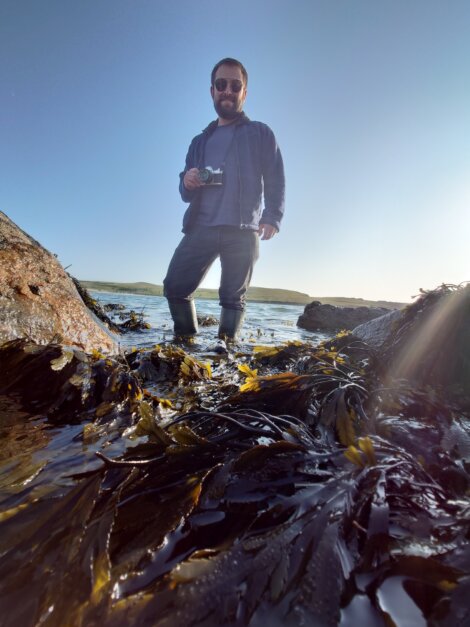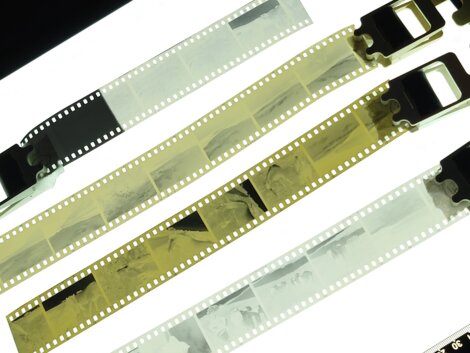Arts / Vintage photography enthusiast testing seaweed as film developer
IF YOU have ever seen a man in wellies harvesting fresh seaweed from beaches in Lerwick and Burra recently and wondered what was going on – things are set to become a bit clearer.
Vintage photography enthusiast Chris Smith has been collecting pieces of Shetland seaweed to test using it as a way of developing film.
As some of the test black and white photos of the centre of Lerwick in this article show, the results can be quite striking.
The project – called Sea What Develops – has received funding from the Shetland Arts-administered Visual Artist and Craft Maker Awards scheme, while it is also endorsed by the United Nations’ Decade of Ocean Science for Sustainable Development programme.
A key aim of Smith’s project is to reduce reliance on chemical film developers.
He is also keen to create a chart of eco-friendly developing techniques which could be used by other photographers.
Smith, who has held vintage camera workshops for adults and children since moving to Shetland a couple of years ago after gaining an MA in photography at Falmouth University, said developing with seaweed is not a new concept.
But he was keen to build upon this existing knowledge and develop his own practice.
Smith has collected seaweed from the water at the Sands of Sound and Minn beaches.
“I only want to take a small amount – I’d never take more than what I need,” he told Shetland News.
“At the same time I’ve also got to be mindful as to how I’m harvesting.
“I don’t want to damage the seaweed, which would then prevent it from growing. I want to cut it in a way that will promote more growth.”
Become a member of Shetland News
Smith said he has had to understand how film developers work, and the reactions involved.
“I’ve got no chemistry background – I’ve just got a photographic background,” he said.
“Film developing has all been self-taught using whatever resource I could find.”
Smith added that commercial developers’ instructions “tells you how to do it, but it doesn’t tell you how everything works with each other”.
“The first part of the process was to understand that side of it, and understand what it is within plant-based developers that works with the film.”
He said plant-based developers, in particular seaweed, contains a lot of phenols.
These phenols help to convert silver halides in the film emulsion – once exposed to light – into metallic silver, which creates the black and white image.
Smith explained that seaweed is “only one ingredient” in the process.
He has been adding sodium carbonate to adjust the PH of the solution, and ascorbic acid – essentially vitamin C – to accelerate the process.
“Although I’m into slow photography, and I enjoy the slowness of the process, I think developing a film for a couple of hours is a little bit excessive when it comes to slowness.
“By adding that ascorbic acid in it helps to speed it up.”
At the moment the time taken to develop film with seaweed has ranged from between 26 minutes to around one hour.
Smith said one result could be a developing chart which would give information on how long this type of developing takes, for different kinds of film and seaweed.
He has been using fresh seaweed for now but aims to test out what “storm washed” seaweed is like for developing in the future.
Smith’s journey with analogue photography stems back to when he was in his late teens and had his first darkroom experience.
“I absolutely loved it,” he reflected. “It was kind of like the hook that really got me into photography.”
There was a dip in his student years but in 2020 – after the Covid pandemic hit – he bought some film cameras online and rediscovered the joy.
Smith said it was the “thrill of the shooting through the film, the slowing down – getting to process the films myself”.
“It just took me back to that magic that I felt the first time I had ever done it ten years before,” he added.
Seaweed might seem like an unusual developing tool but he already predominantly uses coffee as an eco-friendly alternative.
But it seems the process of discovery is set to continue for the forward-thinking photographer – with “so much research” still to do.
“I’m not an expert by any stretch of the imagination in any of the alternative processes, but that’s because there’s so much to learn,” Smith said.
“I’ll be learning new stuff about it for decades to come.”
Become a member of Shetland News
Shetland News is asking its readers to consider paying for membership to get additional perks:
- Removal of third-party ads;
- Bookmark posts to read later;
- Exclusive curated weekly newsletter;
- Hide membership messages;
- Comments open for discussion.
If you appreciate what we do and feel strongly about impartial local journalism, then please become a member of Shetland News by either making a single payment, or setting up a monthly, quarterly or yearly subscription.


























































